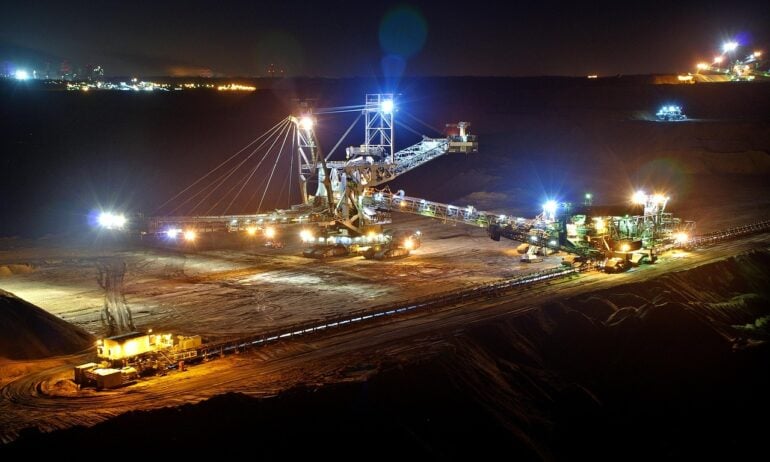5 Best-Performing Rare Earth Stocks in October
Strategic metals like lithium and neodymium are important to high-tech manufacturing. We're looking at the top rare earth stocks, and why recent U.S.-China tariff drama has moved them.

Many, or all, of the products featured on this page are from our advertising partners who compensate us when you take certain actions on our website or click to take an action on their website. However, this does not influence our evaluations. Our opinions are our own. Here is a list of our partners and here's how we make money.
The investing information provided on this page is for educational purposes only. NerdWallet, Inc. does not offer advisory or brokerage services, nor does it recommend or advise investors to buy or sell particular stocks, securities or other investments.
Earlier this month, the Chinese government imposed strict export controls on rare earth elements — economically-valuable heavy metals that mostly come from China.
The new restrictions could imperil the supply chains of many high-tech industries, from electric vehicles to nuclear power, and they’ve kicked off a global scramble for non-Chinese sources of these metals. But one group is already profiting from the chaos: Shareholders of U.S.-listed rare earth stocks.
What are rare earth stocks?
Rare earth stocks are shares of publicly-traded companies involved in the mining and processing of rare earth elements and other strategic metals.
Strictly speaking, the term “rare earth elements” refers to a set of 17 heavy metals whose chemical properties make them useful in advanced technologies such as electric vehicle motors, lasers, large batteries, nuclear reactors and fuel cells. Most of the actual rare earth elements are pretty obscure, though you might have heard of neodymium if you’re really into magnets.
But in common parlance, “rare earth stocks” can also refer to mining companies that produce other valuable metals with high-tech applications, such as lithium, copper and cobalt. These technically aren’t rare earth elements — the more accurate term is “strategic metals” — but in the investing world, they’re often lumped in with the true rare earths due to their similar use cases in advanced manufacturing.
Brokerage firms | |
|---|---|
Top 5 best-performing U.S. rare earth stocks
Below is a table of the best-performing stocks in the WisdomTree Strategic Metals and Rare Earths Miners Index and the MVIS Global Rare Earth/Strategic Metals Index that trade on a major U.S. exchange. They’re listed in order of one-year returns.
» Need a better brokerage for stock trading? If your hands-off, long-term investing plan is all set and you're looking for a brokerage to handle more active trading, take a look at our list of the best brokers for day trading.
Symbol | Company name | 1-year return |
|---|---|---|
MP | MP Materials | 356.44% |
CDE | Coeur Mining | 223.35% |
LAC | Lithium Americas | 154.31% |
IPX | IperionX Ltd. | 119.29% |
AG | First Majestic Silver | 113.22% |
Source: Finviz. Data is current as of market close Oct. 17, 2025, and is intended for informational purposes only.
Why China and tariffs matter for rare earth stocks
Back in April, the Chinese Ministry of Commerce announced that Chinese firms will have to obtain government approval to export seven rare earth elements, citing national security concerns due to the metals’ potential use in military technologies. On Oct. 9, it added another five rare earth elements to the list, and also restricted exports of rare earth element refining equipment.
China mines about 70% of the global supply of rare earth elements. It also accounts for about 60% of global lithium refining capacity, and more than 40% of global copper refining capacity.
The export controls are part of a series of tit-for-tat responses to U.S. trade restrictions. China announced export controls on the original seven rare earth elements in response to President Donald Trump’s sweeping “liberation day” tariffs, and it announced the new controls on five other elements and refining equipment after the U.S. placed new sanctions on several thousand Chinese companies.
Earlier this year, the U.S. government purchased stakes in MP Materials and Lithium Americas, two U.S. producers of strategic metals, in response to Chinese export controls. As part of those deals, the government promised to purchase all of MP Materials’ output from a new, under-construction facility, and allowed Lithium Americas to delay repayment on several hundred million dollars’ worth of debt. These companies are now two of the best-performing strategic metals stocks in the U.S.
Then, on Oct. 10, President Trump threatened to impose an additional 100% tariff on Chinese goods in response to the newest Chinese export restrictions.
Trump is due to meet with Chinese president Xi Jinping at the end of this month for trade talks. If the talks happen — and the two countries reach an agreement to ease off of tariffs and export controls — it could relieve pressure on global tech supply chains, but it could also take some of the oomph out of U.S. rare earth stocks.
The bottom line on rare earth stocks
Some rare earth stocks have surged in the last year due to strong demand and concerns about Chinese export restrictions. But these stocks can be volatile, in part because they’re often caught in the crossfire of the ongoing U.S.-China trade conflict.
Should they have a place in your portfolio? Maybe. But many financial advisors recommend limiting speculative bets on individual stocks to 10% or less of your overall portfolio, and devoting the rest to diversified investments such as index funds.
If you want to invest in strategic metals but don’t like the riskiness of individual stocks, exchange-traded funds are an option, such as the VanEck Rare Earth and Strategic Metals ETF (REMX) and the Sprott Critical Materials ETF (SETM). There are also a few ETFs that invest in miners of a specific metal such as copper or lithium.
It’s also possible to invest in futures contracts on some strategic metals, including copper. But futures trading isn’t for the faint of heart: It can be even riskier than trading individual stocks, and has a steep learning curve for beginners.






